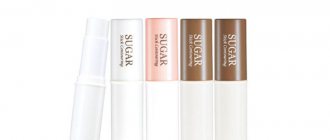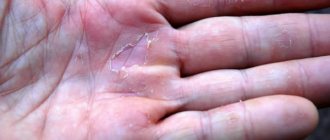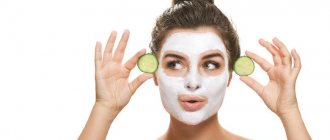Follow the basic rules for applying self-tanning:
- on the eve of the procedure, clean the skin with a scrub or a hard washcloth; on even skin and the tan will lie more evenly;
- Carry out the procedure in the morning, otherwise the self-tanner may smudge at night while you sleep;
- protect your hair, lips, eyebrows and nails, otherwise self-tanning will color them (you can cover them with a layer of rich cream and put a shower cap on your head);
- apply self-tanning to dry, clean skin, which should cool down after water treatments;
- Before applying self-tanning, use a moisturizer to keep your skin smooth, but be sure to let it absorb well for 10-15 minutes;
- Apply self-tanner using sliding circular movements on the body from bottom to top;
- Cover the natural folds of the body, knees and elbows with a very thin layer of self-tanning, and it is better not to touch the armpits at all;
- You won’t be able to treat your back on your own, it’s better to ask a friend for help;
- to avoid the effect of a mask on the face, work especially carefully in the transition area from the neck to the chin;
- Make sure that the skin tone is the same on different parts of the body - do not forget to apply self-tanner to your temples and ears.
How does self tanning work?
In her blog Don't Touch My Face, engineer and petrophysicist Adel Miftakhova explains what cosmetics are made of and how to care for your skin.
And to make it more enjoyable for you to read the text and research from the links, watch this fragment from the 10th season of the TV series “Friends”.
Self-tanning occurs in the skin thanks to a substance called dihydroxyacetone (DHA). It is a simple monosaccharide and is extracted either from beets and sugar cane, or from glycerin.
Dihydroxyacetone reacts with amino acids in the skin, which is why several types of brown pigments are formed in it (amino acids are the building blocks of all living things, proteins and peptides are built from them). This same reaction produces a very characteristic odor. It can be disguised, but any product will give you a slight flair of burnt skin. Funnily enough, this is the same reaction that occurs when baking bread. It's called the Maillard reaction and it's what causes a brown crust to form on bread.
The reaction begins to appear a few hours after application and lasts several days. DHA penetrates only into the very top layer of the skin and works only with dead skin cells. And therefore, no matter what expensive self-tanner you choose, it will not last longer than a conventional week. The price of the jar does not in any way affect the rate of renewal of your skin. But exfoliating before tanning (to remove excess dead skin cells) and moisturizing after the color develops will help prolong the effect of self-tanning.
The color you get from a self-tanner depends on the formula of the product and the purity of the dihydroxyacetone. And here price can already matter. There are other types of sugars that also cause a brown tint, but they are used extremely rarely and are usually paired with dihydroxyacetone. Because they are not as effective.
Self-tanners are relatively safe. Compared to regular tanning, they are completely safe. There is a study that DHA increases the production of free radicals from UV radiation, but it used a concentration that is usually not found in creams. Plus, this effect is neutralized by the use of sunscreen, which should be used in any case. There is research suggesting that chronic self-tanning can irritate the skin, but as always, this depends on the individual.
The biggest danger with self-tanning is that people think it protects from the sun. No, it does not protect from the sun at all. Therefore, along with self-tanning on exposed parts of the body, you must use a cream with SPF.
Source: Don't Touch My Face blog
Read on Zozhnik:
Excess skin: where to put it or just wait?
Minnesota "hunger" experiment of 1944
Easy healthy lifestyle #1: why you need to eat carbohydrates
How dental care can prevent heart disease and facial aging
Tell your friends:
Yulia Kuderova Tuesday, 02/21/2017
Some questions and answers about using self-tanning
- How to protect your palms while applying self-tanning?
The answer is simple: to prevent the palms you work with when applying self-tanning from darkening, you should either wash your hands frequently during the procedure or use thin latex gloves.
- Can I get dressed immediately after applying the product?
After the procedure, self-tanning can leave marks on clothes for another 2-3 hours, so do not get dressed or lie down (especially on light-colored surfaces); Immediately after the procedure, you can put on an old robe. For the first few days, do not wear white clothes or sleep on snow-white bedding.
- What to do if you are not satisfied with the result?
If the tan turns out to be too pale, the entire procedure can be repeated, but not earlier than after 1.5 hours.
If the boundaries between the areas where self-tanning was applied turn out to be too sharp, they can be blurred using a moisturizer: apply a little cream to the desired area and rub lightly.
If you are not satisfied with the overall result, do not be upset. Shower with a scrub and scrub your skin with a stiff washcloth, this will remove the tan from your skin. The procedure can be repeated in a few days.
Useful video
Watch the video on how to tan in one day:
Similar articles
- Self-tanning for legs: how to apply correctly, which one is better...
You can choose a self-tanning for legs taking into account certain rules - the desired tone, the characteristics of the product. It is important to figure out in advance how to apply it correctly and how to quickly wipe it off or wash it off if something goes wrong. Which is the best self-tanner for your legs? Read more - Solarium or self-tanning: which is better and which is more harmful?
Striving for a beautiful tan, you have to study what is better - a solarium or self-tanning. Each of them has its own advantages and disadvantages, but the most important thing is to know which is more harmful to the skin. Read more
- Self-tanning on the face: can it be applied, how to apply it correctly...
You need to choose a self-tanner for your face taking into account your existing problems and phototype. For fake tan to look its best, it needs to be applied correctly. What kind of self-tanner can you use on your face? Read more
- Is self-tanning harmful if used on body skin...
Many people are sure that self-tanning is harmful to both the skin of the face and body. However, manufacturers have long included mainly useful components in their composition. And they are still better than direct sunlight. To reduce the number of side effects, it is important to understand how to use self-tanning. Read more
- Causes of spots after self-tanning
Understanding the reasons why self-tanning appears on your body can be difficult. Sometimes it depends on the application, sometimes on the product itself. Why did the appearance of pigment spots also begin? What is a good self tanner for the body? Read more
Contraindications to self-tanning
- Self-tanning is highly undesirable for allergy sufferers, since the products contain components that can provoke a strong skin reaction. If you still really want to “tan” in this way, do a test: apply a small amount of the product to the area of skin behind the ear or on the bend of the elbow and monitor the skin for 48 hours. If the area turns red, you should not use this product. However, there are also hypoallergenic products, for example, Clinique self-tanners. All of this company's products are tested for allergies 7,200 times, and if even one application causes a reaction during this testing, the product is not released for sale.
- Do not use self-tanner if you have a rash or blemishes on your skin, otherwise the irritation will worsen.
- Do not apply self-tanning under any circumstances during an exacerbation of herpes, there is a risk of spreading the infection throughout the body.?
- Self-tanners dry out the skin quite a bit. Do not use them too often, and if you have dry skin, be sure to combine them with moisturizers.
Skin care after using spray tanning
The spray tanning mechanism is very close to bronzer balms, the main component of which is DHA, which is responsible for dark skin color. Thus, the upper layer of the epidermis acquires the shade. Modern products contain additional ingredients that have a moisturizing and nourishing effect on the skin, so after the procedure it does not require special care. The main thing is to avoid for some time active exercise that promotes heavy sweating, and a hot bath with shower.
Self-tanning spray is absolutely harmless. The golden color lasts on average 10-12 days. The shade fades over time, so if you want to keep it longer, it is recommended to repeat the procedure once a week. The most effective way to prolong the effect of the product is to regularly moisturize the skin, and instead of long and warm baths, choose a shower.
Spray tanning is the ideal way to get a beautiful and even golden skin tone.
It is a compromise between sunbathing and tanning cosmetics. But remember, you cannot completely give up the sun, which we need for proper functioning and the production of vitamin D. We recommend:
Cosmetics for tanning in a solarium
Tags: cosmetics, body, body care, tanning, tanned skin
- Related Posts
- Anti-aging cosmetics - prolong your youth!
- The use of tea tree oil in cosmetology and medicine
- Useful properties and uses of macadamia oil
« Previous entry
Salon tanning
Those who do not want to bother with auto-bronzants themselves can resort to the salon tanning procedure. Its convenience lies in the speed of application - just a couple of minutes is enough, and you will get the desired bronze shade. Before the procedure, you will be exfoliated, and the spray system will ensure an even application of self-tanning, leaving no spots or streaks. Tanning shades vary: mountain, sea, tropical - to suit your taste. In addition, salon products are devoid of the specific smell of cosmetics, which some may find unpleasant.
Using spray tanning
A tanning session requires proper skin preparation. Before the procedure, you should do a very thorough peeling. The body must be completely dry. If you have recently applied any cosmetics, remove them thoroughly.
If you choose to apply self-tanning in a cosmetologist's office, you will be asked to enter a machine where the product in the form of a mist will be applied to the body. The procedure lasts about 15 minutes, and the next 15 minutes is the drying stage. Contrary to all the myths surrounding spraying, it does not cause spots, streaks or even an unnatural orange tint. In addition, self-tanning liquid contains care ingredients, so it does not harm the skin, but cares for it, for example, moisturizes and nourishes it with useful substances.
When applying the spray yourself at home, you must first shake the solution thoroughly, then evenly spray the entire body with it from a distance of 20-25 cm. After which you should easily and carefully distribute it over the skin with a soft napkin. After 10 minutes you can apply the 2nd layer. The actions are the same. If you need a deeper shade, you should repeat the procedure.
In the video you can see the process of spraying self-tanning spray on the body in a beauty salon and the result after the procedure, and also listen to the opinion of an expert:
Below are photos before and after applying the spray tan. As you can see, the tan covers the body evenly, without spots or smudges, and looks beautiful and natural.











